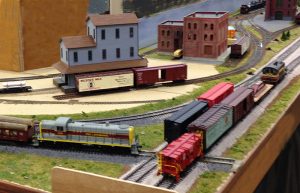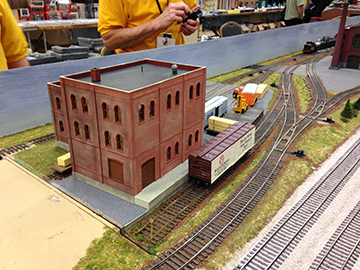These days, in the “S-gauge” world, the term “scale modelers” (A.K.A. “scalers”) refers to modelers who want to own and build realistically sized and detailed models. Upon careful consideration, the common use of the term “S-gauge” to refer to all 3/16 scale modeling is unfortunate, because it confuses the terms scale and gauge. In fact, post-war American Flyer (AF) has been mostly 3/16 scale size and still looks good when grouped with modern production S-scale models. The term gauge is technically the distance between the rails and in the real world can vary depending on time and place. In the US, standard gauge trains have 4 ft 8 1/2 in distance between the rails; narrow gauge is narrower (examples: 3 ft, 2 ft, 42 in), trollies are usually wider.
(Click on photos to enlarge)
In the Pittsburgh S-Gaugers club, there are members interested in Scale-S modeling, which means that they want models that are as true to the real thing (the prototype) as they can get; they want all of the details to be present and accurately sized. American Flyer-S models were intended by A.C. Gilbert to be toys and had a relatively low level of detail and had large wheel flanges and large couplers to improve running reliability for children. By definition, Scale-S models have more realistically sized flanges and couplers. This creates operating incompatibility with AF unless certain steps are taken to adjust for the differences. In general, AF-S trains may be thought of as S-scale with a low level of detail and Scale-S as a high level of detail and Proto-1-64 as the highest level of detail/scale fidelity.
At a practical level, the difference in detail size chosen by the modeler creates problems in two places: coupling cars together (coupler size) and getting cars through turnouts/switches (flange size). It also means that train owners care about model’s details to varying degrees — that of course is a hobbist’s choice.
That being said, in recent years, the differences between the AF/Hi-rail-S and Scale-S hobbiests has been shrinking. Hi-rail-S folks often mix modern, better detailed rolling stock with AF and often try to build layouts that are closer to the real world, just like the Scale-S folks do. It is also common, especially on modern models, to switch couplers to a more realistic size and continue to run with hi-rail wheels. Once that is done, there’s not much difference in appearance in such Hi-rail models/layouts and scale models/layouts.
In summary, that’s what Scale-S is — a concern for accuracy in model details. Those modelers have a natural interest in the real-world prototypes of their models, which extends into modeling approaches, photos, drawings and video; some build their models from “scratch” — no kit involved.
The truth is that there are also some Scale-S modelers who choose hi-rail flanges and maybe even hirail couplers, but want realism otherwise. So these days, the difference between scale and Hi-rail has been greatly diminished. This is a good thing, because it helps to bring S hobbyists together. This is the way it is in the Pittsburgh S-Gaugers Club.



